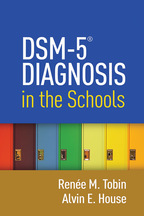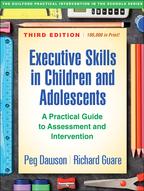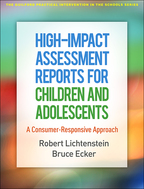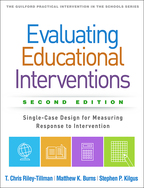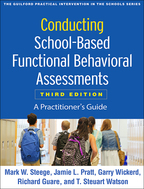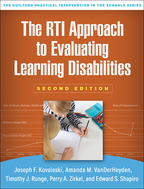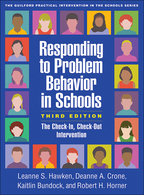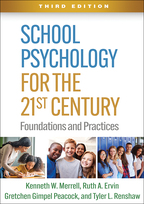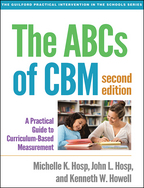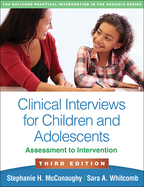DSM-5® Diagnosis in the Schools
Renée M. Tobin and Alvin E. House
Paperbacke-bookprint + e-book
Paperback
orderFebruary 13, 2020
ISBN 9781462543748
Price: $37.00268 Pages
Size: 6" x 9"
Copyright Date: 2016
“An excellent resource primarily for school and clinical psychologists who work with school-age children….This book is an essential supplemental text for psychologists and other mental health providers who work in the schools….The text is user-friendly.”

—NASP Communiqué
“DSM-5 Diagnosis in the Schools provides readers a succinct but extremely thorough overview of key child and adolescent disorders, diagnostics, criteria, symptoms, and evaluation guidelines….Tobin and House provide a thorough review of the Individuals with Disabilities Education Improvement Act (IDEA) and help readers understand how the DSM-5 and IDEA classification systems can be utilized in tandem to best address the pressing needs of students and their educational needs….One of the most readable and helpful professional DSM-related books—past or present. Tobin and House have authored an easy-to-read, highly comprehendible, sufficiently detailed, and logically written book that explains common DSM-5 child and adolescent diagnoses. Moreover, DSM-5 Diagnosis in the Schools plainly describes how to expertly utilize the DSM-5. The outcome is a professionally written, reader-friendly book. It can be used as an adjunct or reference to specific child and adolescent presenting symptomatology or DSM-5 diagnoses. Concomitantly, the book can be used as a cover-to-cover primer read for graduate students or refresher read for school psychologists transitioning from the DSM-IV-TR to the DSM-5….An important contribution to the practice of school psychology. Clearly, school psychologists, school counselors, special education faculty, and teachers working with children and adolescents in school or family settings will find this book a key reference in their professional libraries.”

—Journal of Psychoeducational Assessment
“This book provides a concise yet comprehensive and user-friendly resource to the complexity of the DSM-5. The specific focus on important child and adolescent concerns and applications in the school settings will be particularly useful to school psychologists, as well as professionals and graduate students in the field of child and adolescent clinical or counseling psychology. Overall, this book thoroughly integrates the diagnostic technicalities of DSM-5 with relevant practice in school settings, and will allow practitioners to further their conceptual understanding of assessing and evaluating DSM-5 diagnoses.”

—Canadian Journal of School Psychology
“Tobin and House have provided a coherent, consistent, and valuable review of DSM-5 diagnostic practices for the school psychologist. Used alongside DSM-5, this book will greatly facilitate understanding and application of diagnostic criteria in schools and related settings. After digesting the introductory chapters, practitioners can use the chapters on specific disorders as a handy reference. This book will be helpful as a supplemental text in child psychopathology courses for school psychologists; students will gain an understanding of the conceptual bases of practical diagnostic schema and their utility in deriving effective interventions.”

—Cecil R. Reynolds, PhD, Editor-in-Chief, Psychological Assessment
“This is one of the most important books for school psychologists—both new and experienced—and for graduate students wishing to enter this complex, challenging, and exciting field. DSM-5 interfaces with all areas of applied psychology and with IDEA, and school psychologists must be proficient in its use and applications. Clearly, the authors know and respect the demands facing practitioners; chapters provide informative descriptions of the many types of referrals seen in the school context. Not only do the authors demystify DSM-5 and its relevance to diagnosis and program planning, but they also include their own perspectives and practical guidance.”

—Donald H. Saklofske, PhD, Department of Psychology, University of Western Ontario, Canada
“This book elucidates how and when to translate a psychiatric diagnosis or developmental disability into a special education eligibility category. It provides best-practice recommendations for incorporating DSM-5 diagnosis into the decision making of school teams. The authors also address questions about licensure and certification to explain, for example, why some school psychologists can diagnose ADHD while others cannot. In addition to school psychologists, counselors, social workers, speech-language pathologists, and autism specialists will find this book immeasurably helpful.”

—Tammy L. Hughes, PhD, Fr. Martin A. Hehir Endowed Chair for Scholarly Excellence, Department of Counseling, Psychology and Special Education, Duquesne University
“An essential addition to the professional libraries of school psychologists, who are increasingly being asked to provide DSM-5 diagnoses and to interpret the diagnostic reports of other mental health professionals working in the community. The book focuses on the particular challenges of using DSM-5 to diagnose children and adolescents using data collected in the school setting. The authors draw on extensive clinical experience to provide their personal perspectives, many examples from school-based practice, suggestions for additional sources of diagnostic information, and best-practice recommendations. For readers who have used previous editions of the DSM, Tobin and House clearly explain what has changed in DSM-5. The book will serve as an excellent supplemental text for graduate students in school psychology.”

—Mark E. Swerdlik, PhD, ABPP, Coordinator, Graduate Programs in School Psychology, Illinois State University
“This book is a 'must have' for all current and future school psychologists, school counselors, and mental health workers. It provides in-depth analysis of DSM-5 and what 'diagnosis in the schools' means through the practitioner lens. As a text, it is a great addition to any clinical or child psychopathology course. My students were able to easily find best-practice recommendations and case study examples to enhance their learning.”

—Diana L. Wildermuth, PhD, NCC, LPC, Department of Psychological Studies in Education, Temple University
—NASP Communiqué
“DSM-5 Diagnosis in the Schools provides readers a succinct but extremely thorough overview of key child and adolescent disorders, diagnostics, criteria, symptoms, and evaluation guidelines….Tobin and House provide a thorough review of the Individuals with Disabilities Education Improvement Act (IDEA) and help readers understand how the DSM-5 and IDEA classification systems can be utilized in tandem to best address the pressing needs of students and their educational needs….One of the most readable and helpful professional DSM-related books—past or present. Tobin and House have authored an easy-to-read, highly comprehendible, sufficiently detailed, and logically written book that explains common DSM-5 child and adolescent diagnoses. Moreover, DSM-5 Diagnosis in the Schools plainly describes how to expertly utilize the DSM-5. The outcome is a professionally written, reader-friendly book. It can be used as an adjunct or reference to specific child and adolescent presenting symptomatology or DSM-5 diagnoses. Concomitantly, the book can be used as a cover-to-cover primer read for graduate students or refresher read for school psychologists transitioning from the DSM-IV-TR to the DSM-5….An important contribution to the practice of school psychology. Clearly, school psychologists, school counselors, special education faculty, and teachers working with children and adolescents in school or family settings will find this book a key reference in their professional libraries.”
—Journal of Psychoeducational Assessment
“This book provides a concise yet comprehensive and user-friendly resource to the complexity of the DSM-5. The specific focus on important child and adolescent concerns and applications in the school settings will be particularly useful to school psychologists, as well as professionals and graduate students in the field of child and adolescent clinical or counseling psychology. Overall, this book thoroughly integrates the diagnostic technicalities of DSM-5 with relevant practice in school settings, and will allow practitioners to further their conceptual understanding of assessing and evaluating DSM-5 diagnoses.”
—Canadian Journal of School Psychology
“Tobin and House have provided a coherent, consistent, and valuable review of DSM-5 diagnostic practices for the school psychologist. Used alongside DSM-5, this book will greatly facilitate understanding and application of diagnostic criteria in schools and related settings. After digesting the introductory chapters, practitioners can use the chapters on specific disorders as a handy reference. This book will be helpful as a supplemental text in child psychopathology courses for school psychologists; students will gain an understanding of the conceptual bases of practical diagnostic schema and their utility in deriving effective interventions.”
—Cecil R. Reynolds, PhD, Editor-in-Chief, Psychological Assessment
“This is one of the most important books for school psychologists—both new and experienced—and for graduate students wishing to enter this complex, challenging, and exciting field. DSM-5 interfaces with all areas of applied psychology and with IDEA, and school psychologists must be proficient in its use and applications. Clearly, the authors know and respect the demands facing practitioners; chapters provide informative descriptions of the many types of referrals seen in the school context. Not only do the authors demystify DSM-5 and its relevance to diagnosis and program planning, but they also include their own perspectives and practical guidance.”
—Donald H. Saklofske, PhD, Department of Psychology, University of Western Ontario, Canada
“This book elucidates how and when to translate a psychiatric diagnosis or developmental disability into a special education eligibility category. It provides best-practice recommendations for incorporating DSM-5 diagnosis into the decision making of school teams. The authors also address questions about licensure and certification to explain, for example, why some school psychologists can diagnose ADHD while others cannot. In addition to school psychologists, counselors, social workers, speech-language pathologists, and autism specialists will find this book immeasurably helpful.”
—Tammy L. Hughes, PhD, Fr. Martin A. Hehir Endowed Chair for Scholarly Excellence, Department of Counseling, Psychology and Special Education, Duquesne University
“An essential addition to the professional libraries of school psychologists, who are increasingly being asked to provide DSM-5 diagnoses and to interpret the diagnostic reports of other mental health professionals working in the community. The book focuses on the particular challenges of using DSM-5 to diagnose children and adolescents using data collected in the school setting. The authors draw on extensive clinical experience to provide their personal perspectives, many examples from school-based practice, suggestions for additional sources of diagnostic information, and best-practice recommendations. For readers who have used previous editions of the DSM, Tobin and House clearly explain what has changed in DSM-5. The book will serve as an excellent supplemental text for graduate students in school psychology.”
—Mark E. Swerdlik, PhD, ABPP, Coordinator, Graduate Programs in School Psychology, Illinois State University
“This book is a 'must have' for all current and future school psychologists, school counselors, and mental health workers. It provides in-depth analysis of DSM-5 and what 'diagnosis in the schools' means through the practitioner lens. As a text, it is a great addition to any clinical or child psychopathology course. My students were able to easily find best-practice recommendations and case study examples to enhance their learning.”
—Diana L. Wildermuth, PhD, NCC, LPC, Department of Psychological Studies in Education, Temple University

